Compressors are among the most undervalued effects pedals and somewhat of a mystery to many bass players out there. Whether on stage or in the studio, compressors are instrumental in making your bass tone cut through the mix. If you’ve never tried one, you could think your tone is just fine without one, but once you’ve figured out compressors, it will be hard to ignore the benefits they bring to your bass tone.
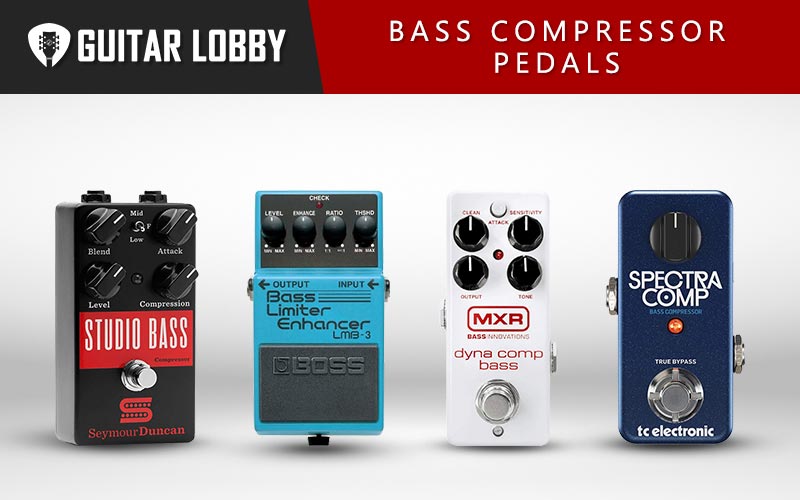
I’ll start this article by jumping straight into reviews on the best bass compressor pedals at each price point, but if you want to learn more about compressors before reading reviews, check out the buying guide at the bottom of the page.
| Name of Product | Image of Product | Description | Price Range | Full Review |
|---|---|---|---|---|
| 1. MXR M87 Bass Compressor (Best Overall) | 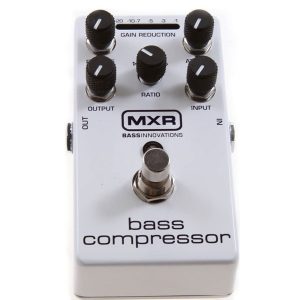 | Type: Analog Bass Compressor Pedal Compressor Tech: FET compression | $190 | Read Full Review Below |
| 2. MXR M282 Dyna Comp Bass Compressor (Best Value) | 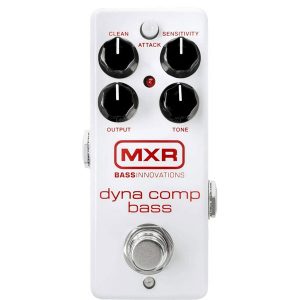 | Type: Analog Bass Compressor Pedal Compressor Tech: OTA compression | $150 | Read Full Review Below |
| 3. Aguilar TLC Bass Compressor (Editor's Choice) | 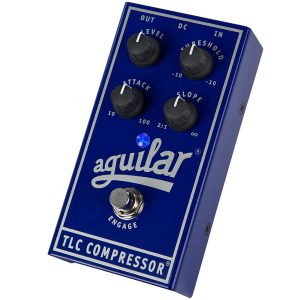 | Type: Analog Bass Compressor Pedal Compressor Tech: proprietary TLC compression (probably a form of VCA circuit) | $220 | Read Full Review Below |
| 4. Electro-Harmonix Bass Preacher (Best Cheap) | 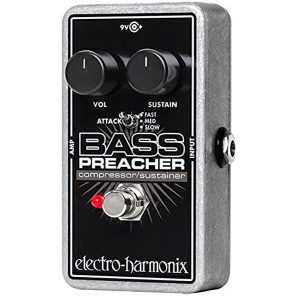 | Type: Analog Bass Compressor Pedal Compressor Tech: Analog compression circuit | $90 | Read Full Review Below |
| 5. Keeley Bassist Limiting Amplifier | 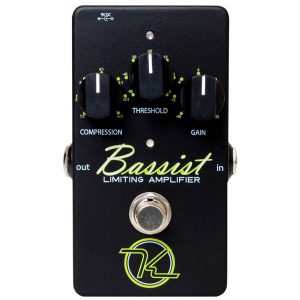 | Type: Analog Bass Compressor Pedal | $230 | Read Full Review Below |
| 6. Boss BC-1X Bass Compressor | 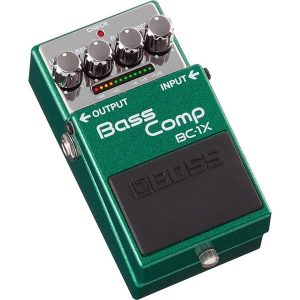 | Type: Digital Multi-band Bass Compressor Pedal Compressor Tech: Digital compression | $200 | Read Full Review Below |
| 7. Seymour Duncan Studio Bass | 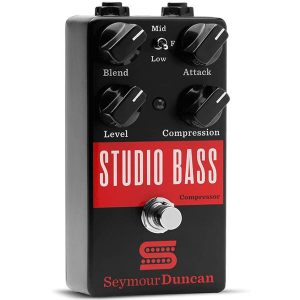 | Type: Analog Bass Compressor Pedal Compressor Tech: VCA compression | $170 | Read Full Review Below |
| 8. BOSS LMB-3 | 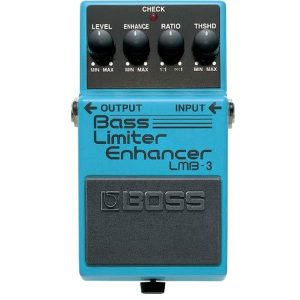 | Type: Analog Bass Compressor Pedal Compressor Tech: VCA compression | $100 | Read Full Review Below |
| 9. TC Electronic Spectra Comp Bass Compressor | 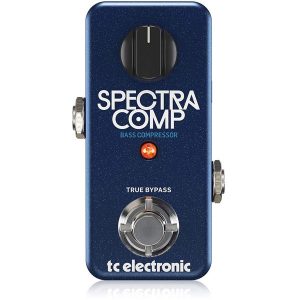 | Type: Digital Multi-band Bass Compressor Pedal Compressor Tech: Multi-Band Compression | $100 | Read Full Review Below |
| 10. EBS Multi-Comp | 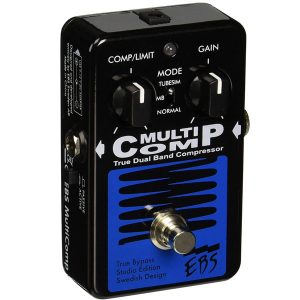 | Type: Analog Multi-band Bass Compressor Pedal Compressor Tech: Multi-band Compression | $230 | Read Full Review Below |
| 11. Ampeg Opto Comp | 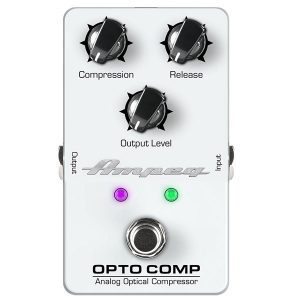 | Type: Analog Bass Compressor Pedal Compressor Tech: Optical compression | $130 | Read Full Review Below |
Her Are the Best Bass Compressor Pedals
1. MXR M87 Bass Compressor (Best Overall)
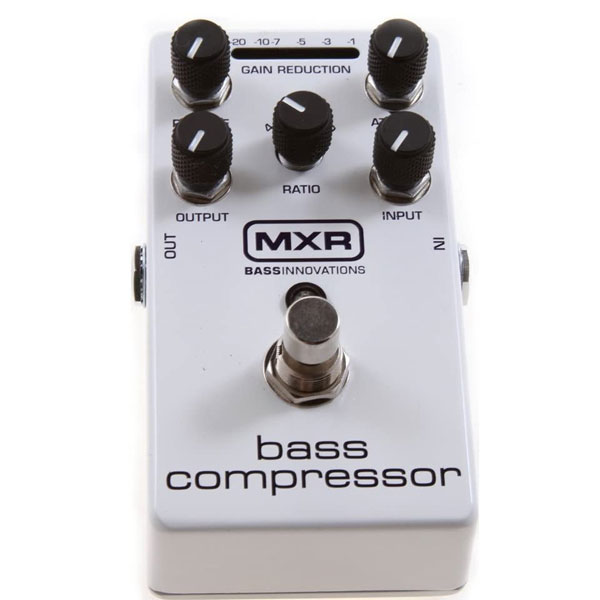
| Estimated Price | $190 |
| Type | Analog Bass Compressor Pedal |
| Compressor Tech | FET compression |
| I/O | 1×1/4” input, 1×1/4” output |
| Power Supply | 9V PSU or 9V block battery |
My Review: MXR has built a studio-quality analog FET compressor into a standard sized bass pedal that sounds very transparent and doesn’t color your tone. Many pedal-format compressors have too few controls to let you dial in the settings you want, but the M87 Bass compressor gives you access to 5 control functions to shape your sound as you please, Attack, Release, compression Ratio (selectable between 4:1,8:1,12:1 and 20:1), plus separate Input and Output level controls. The attack time has a very usable range and can be set from 20ms to 800ms, while the release time ranges from 50ms to 1.1 secs.
The ratio knob lets you choose between some of the more frequently used compression ratios, 4:1 and 8:1 being the ones you’ll probably use most of the time, without losing too much of your dynamic range. The input acts as your threshold control, setting the level at which the compressor kicks in (when the LED display lights up), while the output controls your make-up gain. You can also use the M87 as a limiter, as it also features a 20:1 ratio, enabling you to soft limit your output volume if you wanted to protect your speakers, for example. The Constant Headroom Technology (CHT) MXR has built into this little compressor ensures that you have plenty of headroom for any of your dynamic needs until you reach the compression threshold and the 10 LED display lights up showing you by how much your signal is attenuated when the compressor starts working. While some compressors add a lot of hiss to your sound when they kick in, the M87 is almost silent in this regard. It features a true bypass circuit, comes with a small footprint, and is totally transparent.
Key Specs: The MXR M87 bass compressor features a full set of controls to tweak it to your liking. It has a 5 knob control layout with attack, release, and ratio plus the input control(acting as a threshold control) and the output knob setting the make-up gain. The 10 LED display comes in handy when you’re setting the threshold (using the input control), it lights up to let you know when the compression kicks in. It has a true bypass circuit making sure that your tone doesn’t degrade while the unit is on, and it can also function as a limiter.
Target Customer: The MXR M87 can be harder to properly set up for the uninitiated when compared to a 1 or 2-knob compressor, but the versatility it offers is unquestionable. Few other bass compressors on the market let you have as much control over your compression parameters.
Bottom Line: This is a great pedal for any bass player who wants to dig deeper into compressors. You basically get noiseless compression with the ability to alter all the relevant compression parameters, and with a very transparent tone. It’s one of the best compressors on the market.
2. MXR M282 Dyna Comp Bass Compressor (Best Value)
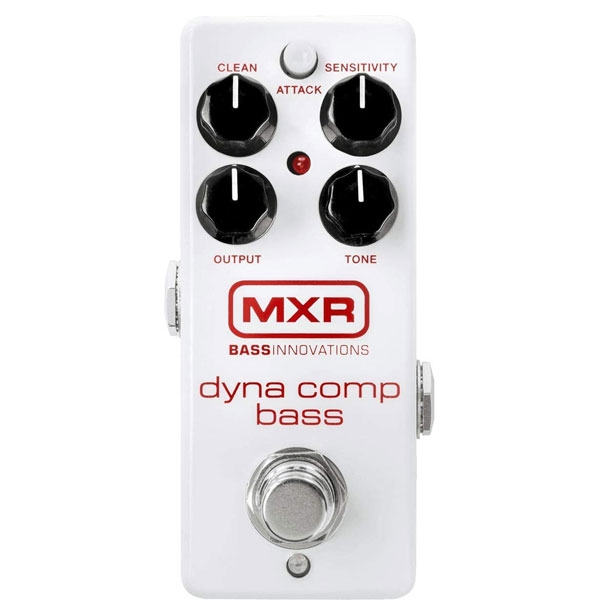
| Estimated Price | $150 |
| Type | Analog Bass Compressor Pedal |
| Compressor Tech | OTA compression |
| I/O | 1×1/4” input, 1×1/4” output |
| Power Supply | 11mA@9V PSU only |
My Review: If you feel you are in need of a simple, easy to use compressor or your pedalboard starts to get cramped or if you are on a budget but you don’t want to compromise on sound quality – the MXR Dyna Comp Bass may tick all these boxes for you. The Dyna Comp Bass is an all-analog bass compressor, built around the iconic CA3080 circuit, exactly like its predecessor the iconic bright red, 2 knob 1970s Dyna Comp, which to this day remains a popular compressor choice for guitar and bass players alike. The Dyna Comp Bass is a bass focused stompbox housed in a miniature enclosure, so you will not have any trouble finding a place for it on your cramped pedalboard. This pedal makes dialing in your compression easy and straightforward.
It gives you 4 knobs to fiddle with Output, Clean, Tone, and Sensitivity plus the Attack switch that sets the range of attack times. It is relatively quiet during operation when compared to some other compressors on the market, but noiseless it is not. Blending in your dry signal with the compressed one eliminates compression artifacts while maintaining sustain. While some compressors often tend to lose some high-end frequencies during operation, the M282 features a tone control, that lets you boost or cut the highs so you won’t miss that top-end sparkle. The Dyna Comp Bass also makes it possible to blend in your dry signal along with the compressed signal, so that your lows stay punchy when compressing. The MXR M282 sounds transparent, and musical without changing the fundamental tone of your bass.
Key Specs: The Output knob adjusts the volume of the compressed signal, Clean blends your wet and dry signals together, Tone boosts or cuts the midrange by 7dB@1kHz and Sensitivity lets you adjust sustain (probably a combination of compression ratio and release). The Attack switch lets you choose between shorter and longer attack times. This is an all-analog compressor built into the increasingly popular “miniature” pedal enclosure, taking up very little space on your pedalboard. It will only run on a standard 9V PSU, being too small for a 9V battery.
Target Customer: The MXR Dyna Comp Bass is an analog compressor for the no-frills bass player. It makes dialing in your tone easy, straightforward, and fast, without having to read the manual first. It’s basically plug and play.
Bottom Line: This is a powerful and versatile compressor pedal with a very small footprint and good build quality that does a great job without adding too much color to your tone. Considering its price and overall performance, I would say this is easily one of the best bass compressor pedals out there.
3. Aguilar TLC Bass Compressor (Editors Choice)
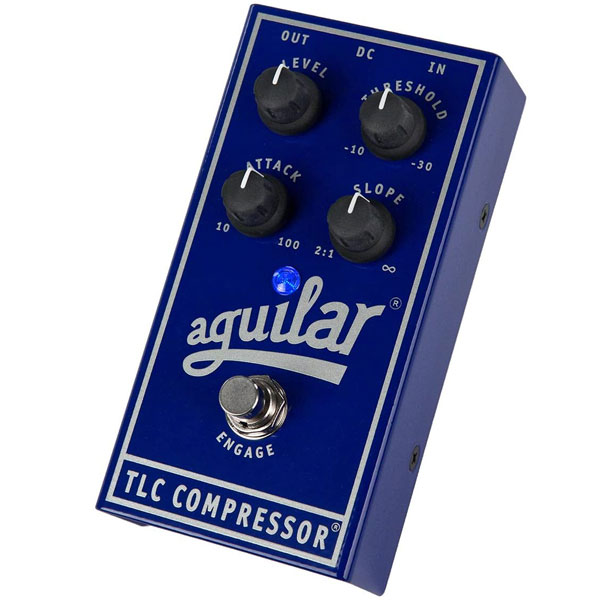
| Estimated Price | $220 |
| Type | Analog Bass Compressor Pedal |
| Compressor Tech | Proprietary TLC compression (probably a form of VCA circuit) |
| I/O | 1×1/4” input, 1×1/4” output |
| Power Supply | 9V PSU or 9V block battery |
My Review: Aguilar Amplification has created a very well thought-out compressor pedal with the TLC Bass Compressor. This is a clean and transparent compressor with a fully-featured set of controls housed in a small and rugged bright blue enclosure. Its layout features 4 control knobs that let you tweak most of the compression parameters you would want: Level is effectively the make-up gain, Threshold sets the level at which the compressor kicks in and has a wide enough range to accommodate all kinds of instruments not just bass guitars.
Attack defines how quickly you reach maximum compression, and Slope determines the compression ratio. The Attack has a rather narrow range(10ms-100ms), such short attack times often produce effects too subtle to be perceived and are most useful with percussive performances, less so when playing long, sustained notes. The Slope control sets the desired compression ratio and ranges from 2:1 up to infinity, making it possible to use the TLC for hard peak limiting as well as lighter smoothing of the dynamic peaks. The TLC is mostly transparent when in use, without any noticeable coloration of your tone or the addition of “warmth” that some might prefer, though the lows get slightly tightened, while the highs seem unaffected by the compression. The TLC is an all-analog compressor that uses Aguilar’s proprietary Trans Linear Control circuitry for its compression (hence TLC) that they claim will enhance your dynamic response in a positive way. In practice, this is probably a form of modified VCO circuit. As with any compressor, the TLC raises the noise floor a bit, but it is almost inaudible.
Key Specs: The TLC features 4 control knobs: Level – adjusts the output level of the pedal from -infinity to -3dBu, the Threshold knob varies the point at which the compressor engages from -30dBu to -10dBu, Attack sets how fast the compressor will respond when reaching the threshold from 10ms to 100ms and Slope which lets you dial in the compression ratio from 2:1 to infinity. The TLC features a true bypass which is always a nice feature to have. The TLC is built to high construction standards and is housed in a rugged enclosure. You can also power it with a 9V block battery.
Target Customer: The TLC is a high-quality compressor aimed at the sonically demanding bass player. It offers a good amount of versatility, being able to accommodate all kinds of instruments, not just the bass guitar. The great build quality and clear, smooth, and transparent sounds make the TLC a great fit for any situation that warrants a compressor, and it is fairly priced for what it offers.
Bottom Line: If you are looking to get a very quiet, transparent, well-designed compressor, with control over most of your compression parameters, give The TLC Bass compressor an ear or two.
Popular Related Article: Our Favorite Bass Guitars (All Price Ranges)
4. Electro-Harmonix Bass Preacher (Best Cheap Pedal)
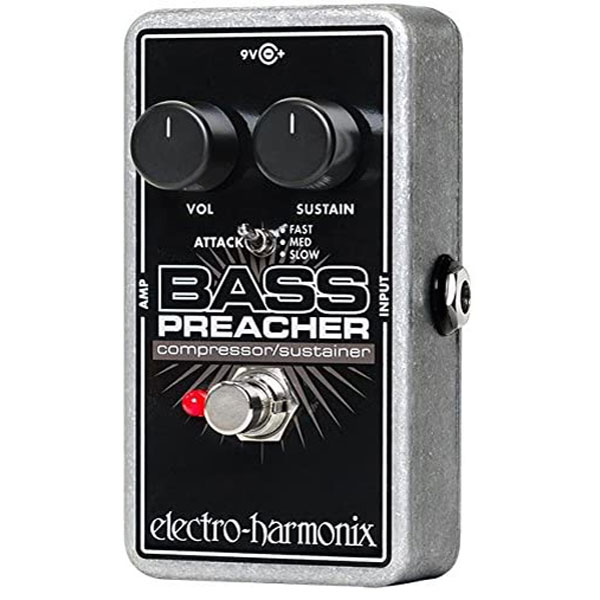
| Estimated Price | $90 |
| Type | Analog Bass Compressor Pedal |
| Compressor Tech | Analog compression circuit |
| I/O | 1×1/4” input, 1×1/4” output |
| Power Supply | 9V PSU or 9V block battery |
My Review: Electro-Harmonix brought out the Soul Preacher Nano not too long ago as a miniature of their legendary ’70s Soul Preacher Compressor/Sustainer. It was a good pedal, but it performed much better with guitars than with basses. This is not to say that bass players didn’t enjoy the Soul Preacher, just that it needed a few tweaks to make it stand out as a compressor for bassists. And that is exactly what they did. They took the Soul Preacher and tailored it to better suit modern bass players, creating the Bass Preacher compressor. It is housed in the same enclosure as the Soul Preacher Nano, so it’s built like a tank. The Bass Preacher has a 2 knob layout with a Volume control that serves as the make-up gain, and a Sustain knob that sets the compression ratio.
There’s also a 3-way switch that lets you select between fast, medium, and slow attack times. The Bass Preacher features two major improvements to the original Soul Preacher. First, they gave the Sustain knob a wider range of control enabling a finer adjustment of the ratio from light to medium compression, this is like allowing for a higher threshold, which is important if you don’t want your dynamics to be compressed too much resulting in a lifeless bass tone. The wider compression range also means that less make-up gain is required, resulting in less noise. The second improvement is to the frequency response of the pedal, producing a punchier low end with a less pronounced high-end. Above 5 kHz the highs drop off sharply, this helps to filter out the hiss that the Soul Preacher was known to produce. With all these improvements, the Bass Preacher is still a little noisy, especially when you crank up the volume knob(make-up gain), but at lower sustain (compression ratio) settings, it’s not that bad. The Bass Preacher colors your tone quite a bit, but it always sounds fat, punchy, and musical.
Key Specs: The Bass Preacher is an all-analog compressor pedal with lots of tonal character. Its input sensitivity of -10dBu to +2dBu will easily accommodate passive as well as active basses. It has a 2 control knob layout with Volume(make-up gain) and Sensitivity(compression ratio). Attack times are selectable through the use of a 3-way dip-switch. It’s housed in EHX’s nano-sized enclosure, and it can be powered either with a 9V battery or standard 9V PSU.
It also features a true bypass circuit, so it will not degrade your tone when not in use.
Target Customer: This is a lot of pedal for the price. It has a good assortment of usable compression settings, though it can get noisy at higher compression ratios that require you to turn up the make-up gain. It would be a good fit for the bass player who wants a little compression in his setup that doesn’t break the bank.
Bottom Line: The Bass Preacher offers a lot of character in its compression sound, with enough versatility for the no-frills bassist who just wants a simple and easy to use bass compressor pedal at a fair price. Its small form factor means that it surely will find a place on a crowded pedalboard. If you’re looking for the best bass compressor pedal and you’re on a tight budget, this is an excellent option.
5. Keeley Bassist Limiting Amplifier
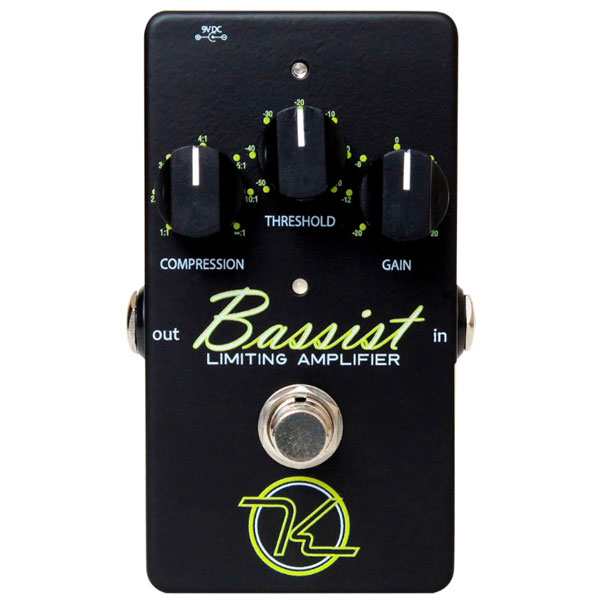
| Estimated Price | $230 |
| Type | Analog Bass Compressor Pedal |
| Compressor Tech | VCA compression |
| I/O | 1×1/4” input, 1×1/4” output |
| Power Supply | 9V PSU or 9V block battery |
My Review: Keeley Electronics are known for their premium compressors aimed at guitar players, but the Bassist Limiting Amplifier is designed specifically for us bass players. In essence, it’s a bass-oriented Keeley GC2 that has seen great success among guitar players. But the mods to the Bassist make it react less to peaks in the low end, resulting in a more effective hard limiter. It is built around the high fidelity THAT Corp. 4320 chip bringing studio-grade performance to a pedalboard-friendly format. The Bassist is a high-quality VCA compressor with a very low noise floor (it’s very quiet while in use) and the high bandwidth of over 20kH ensures that your high-end stays intact when you turn it on.
It features a 3 control knob layout, with Compression, Threshold, and Gain, while Attack and Release are set automatically depending on your dynamics while playing. The Compression ratio ranges from 1:1 up to infinity:1 (you can use it as a hard peak limiter). The Threshold has a very wide range, being able to accommodate instruments with very low as well as very high output. It also has a LED that lets you know when the set threshold has been reached, it lights up green while under and red when the threshold has been reached. The Bassist has a clean and transparent tone, some could claim it sounds too “sterile”, but if you want absolutely no character imparted by your compressor, you will love it. There is no perceptible loss of either lows or highs at medium compression settings.
Key Specs: The Bassist features a 3 control knob layout: Compression (adjusting the compression ratio from 1:1 up to :1), Threshold – determines the point at which the compressor kicks in, and Gain sets the output volume of the pedal (make-up gain). Attack and Release times are set automatically and continuously depending on the way you play, higher peaks result in shorter attack times and longer release times. It can be used as a transparent clean boost, or as a hard peak limiter, it has a LED to let you know when you’ve reached the set threshold, and it has a true-bypass circuit. The build quality is excellent and the enclosure is very compact for such a potent compressor. It can run on a 9V battery or 9V PSU.
Target Customer: Keeley’s Bassist Limiting Amplifier is a high-quality multi-purpose pedal for the bass player who wants his tone untouched by his compressor. It can double as a fully transparent clean boost and also a potent peak limiter. Its price is rather on the high end of the spectrum, but you get a lot for what you pay.
Bottom Line: This is one of the best compressor pedals you can get, in any price range. It’s fully transparent at moderate compression settings, has great build quality, and comes in a diminutive package. All around it’s an excellent compressor.
Popular Related Article: The Best Bass Pickups on the Market
6. Boss BC-1X Bass Compressor
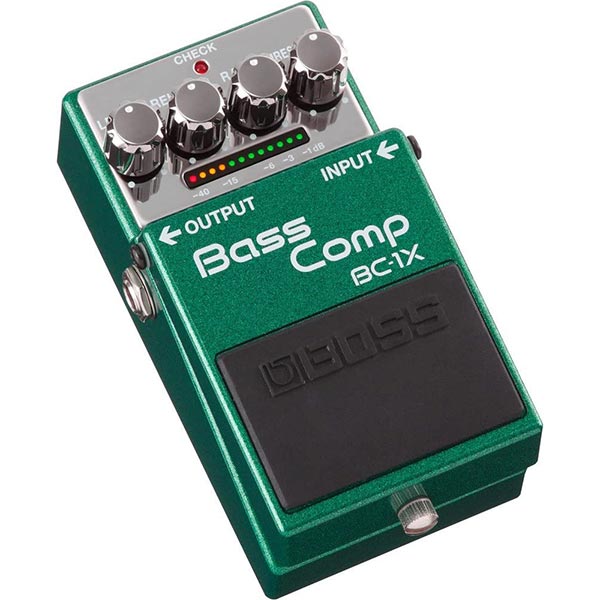
| Estimated Price | $200 |
| Type | Digital Multi-band Bass Compressor Pedal |
| Compressor Tech | Digital compression |
| I/O | 1×1/4” input, 1×1/4” output |
| Power Supply | 9V PSU or 9V block battery |
My Review: The Boss BC-1X is a digital multi-band compressor, packed to the brim with intelligent pro-grade circuitry. It features multi-band compression that will split your signal into separate frequency ranges, each will be processed separately and the signals are then recombined at the output. This means that peaks in the low-end will only trigger the compression of the lows without affecting the midrange or high-end, resulting in a cleaner, more transparent tone. The BC-1X has a simple 4 knob control interface: Threshold, Ratio, Release, and Level, giving you easy access to the most useful compression parameters. The multi-band processing works great and has a very low noise floor at most settings. The tone it delivers is bright and transparent without any discernible loss of bass or treble frequencies. The lows sound tighter and the high-end is pushed forward in the mix but it never sounds harsh. It doesn’t handle hard peak limiting as well as other compressors, but it does very well in all other areas, with particularly good results when slapping and popping.
Key Specs: The BC-1X is a digital multi-band compressor with a 4-knob layout, Threshold sets the level where the compressor kicks in, Ratio sets the amount of compression, Release determines when the compression stops and Level controls the make-up gain.
The 9V DC input gets internally converted to 18V, this ensures that you never run out of headroom and prevents distortion artifacts from high output basses. It also displays the amount of compression applied at all times through the use of a bright and easy to read 16 segment gain reduction indicator.
Target Customer: This is a modern compressor for the modern bass player, fully packed with technology that makes you sound good even if you’ve skipped reading the manual.
Bottom Line: The BC-1X makes bass compression easy. It sounds bright and punchy with just a little coloration of your fundamental tone.
7. Seymour Duncan Studio Bass
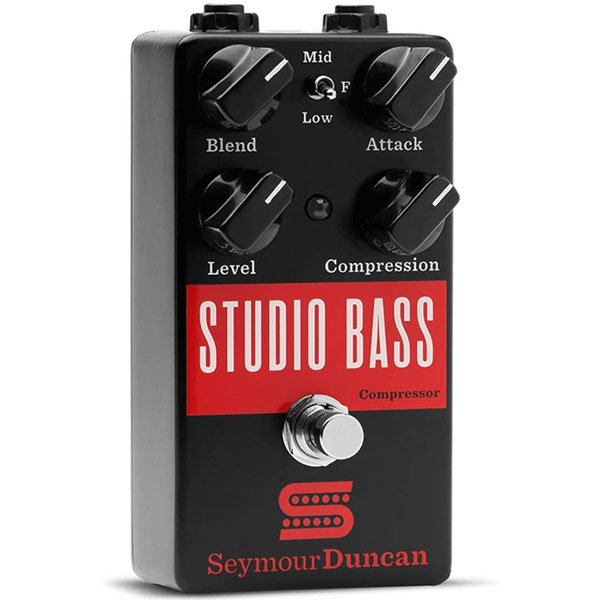
| Estimated Price | $170 |
| Type | Analog Bass Compressor Pedal |
| Compressor Tech | VCA compression |
| I/O | 1×1/4” input, 1×1/4” output |
| Power Supply | 9V PSU or 9V block battery |
My Review: The Studio Bass is a studio-grade pedal from Seymour Duncan, built around a VCA compression circuit. It has a simple 4 knob layout with Compression, Attack, Level, and Blend controls, that are straightforward to use. The Compression control sets your ratio from 1:1 to :1, so you can also use it as a peak limiter, and it also controls your threshold via input gain – a higher compression ratio results in a lower threshold, but your noise floor also gets raised. The Blend knob lets you blend in your choice of lows, mids, or the whole frequency range of your dry signal, selectable through the 3-way switch. This feature comes in handy as compression sometimes leaves the low-end slightly lacking in definition, while in the “mid” position, you get lots of punch and articulation. The range of attack times is fairly short, but are very usable, and Level controls your make-up gain. The release time is fixed, but its value is well chosen. The frequency response of the Studio Bass is flat, you won’t notice any loss of either high- or low-end.
The tone you get from the Studio Bass is clear and transparent, with just a touch of added warmth. Its noise floor is very low but it’s not entirely silent, it’s still better than what most compressors have on offer. The fact that it also runs on an 18V power supply besides the standard 9V means you’ll have more flexibility when setting it up, while also benefiting from the increased headroom 18V operation provides. In the box, you’ll find a few welcome extras like a velcro strip, rubber feet, and dot stickers to mark your favorite settings.
Key Specs: The Studio Bass is a high-quality VCA compressor that’s very easy to use. It has a 4-knob layout with Compression (that sets your desired compression ratio as well as your threshold via input gain), Attack (times are limited to a range that’s on the short side, but are adequate), level sets the make-up gain, and Blend lets you add lows, mids or the full frequency range of your dry signal to the compressed one (selectable via the 3-way toggle switch). It features a true bypass circuit and can run on your choice of 9V battery or 9V or 18V PSU with a center-negative pin
Target Customer: This is a very transparent compressor that adds just a touch of warmth to your signal, if you are looking for more character from your compressor, this one will not give you that. It offers good compression sounds, it’s very easy to set up and the blend control makes it very versatile.
Bottom Line: The Studio Bass offers a lot of value for its price. It sounds great, with a good assortment of usable tones under its belt, it’s very quiet during operation, and comes with a few nice extras in the box.
Popular Related Article: The Best American Made Guitars
8. BOSS LMB-3
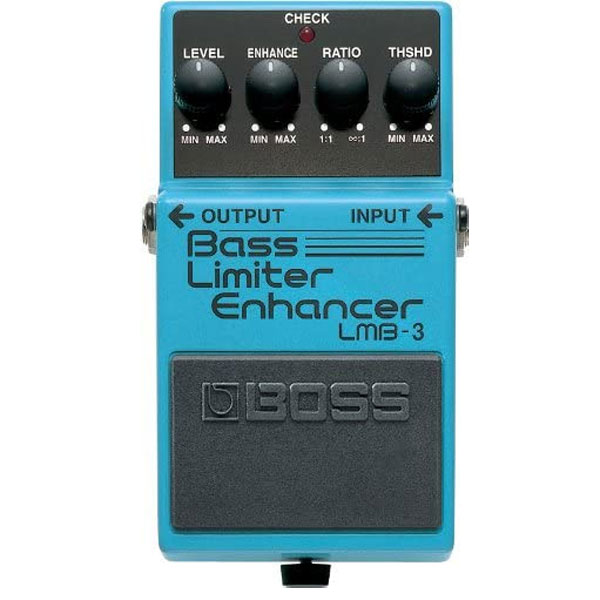
| Estimated Price | $100 |
| Type | Analog Bass Compressor Pedal |
| Compressor Tech | VCA compression |
| I/O | 1×1/4” input, 1×1/4” output |
| Power Supply | 9V PSU or 9V block battery |
My Review: The LMB-3 is an all-round bass compressor workhorse from pedal legend Boss. It is built around a VCA compression circuit ensuring clean and transparent compression with minimal distortion and lots of tweaking options. It features a 4 knob control layout with Threshold, Ratio, Enhance, and Level. The Ratio goes from 1:1 up to :1, this means it can be used as a clean boost and as a hard peak limiter. Enhance lets you add some treble back into the mix if you feel the compression has robbed your sound of some high-end clarity, but your midrange will also be affected by it, resulting in a slightly scooped sound as you turn it up. The tone of the LMB-3 is clear and clean with only the biggest low-end peaks resulting in some slight distortion. At moderate Ratio and Enhance settings its noise floor is very low. The construction quality is to classic Boss standards, meaning rugged and functional.
Key Specs: The LMB-3 uses a VCA compression circuit as its base. It has a 4 control knob layout: Threshold determines when the compression kicks in, Ratio sets the compression ranging from 1:1 to :1, Enhance cuts or boosts treble at 2kHz but it also affects the midrange somewhat, and Level sets your make-up gain. The pedal is not “true bypass”, it uses a very transparent bypass circuit. It can run on a 9V battery or a standard 9V PSU.
Target Customer: This is a simple workhorse pedal that offers all you need from a bass compressor: a good assortment of usable sounds, a low noise floor, and you get the option to use it as a limiter or as a clean boost.
Bottom Line: This is one of the most versatile compressors in its price range, it does a great job with any playing style or music genre. It’s the underdog among bass compressors.
9. TC Electronic Spectra Comp Bass Compressor
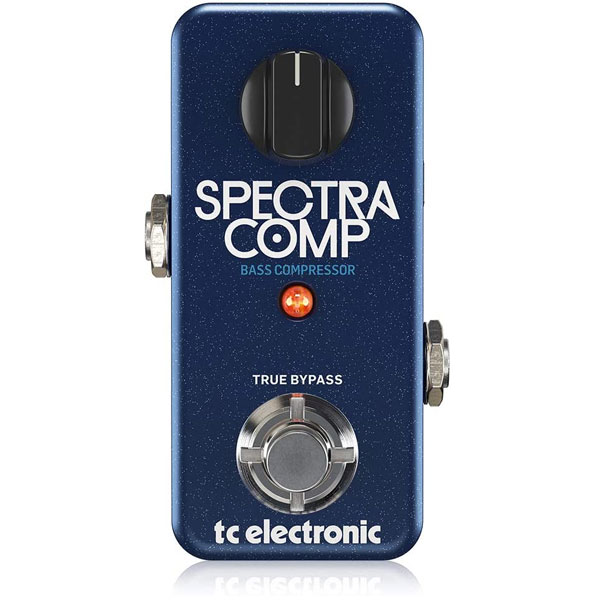
| Estimated Price | $100 |
| Type | Digital Multi-band Bass Compressor Pedal |
| Compressor Tech | Multi-Band compression |
| I/O | 1×1/4” input, 1×1/4” output, mini USB port |
| Power Supply | 9V PSU only |
My Review: TC Electronic is known for its simple to use, high-quality pedals housed in the tiniest enclosures, and the Spectra Comp is no different. It is a digital multi-band compressor crammed into their “mini” enclosure. It only has one control knob that takes care of your compression needs. The way a 1-knob compressor becomes a versatile tool in TC’s book is by having it support their TonePrint feature. This functionality lets you beam one preset compressor from your iPhone or Android, directly to the pedal, it’s like having dozens of compressors at the touch of a button. Using the TonePrint Editor on mac or PC gets you access to a multitude of parameters enabling you to tailor the compression settings of the Spectra Comp to your liking and loading it to your pedal. How it sounds depends on the TonePrint you have loaded into it, but generally, the sound quality is excellent with a very low noise floor.
Key Specs: The Spectra Comp is a digital 1-knob multi-band compressor housed in a tiny enclosure. It features TC Electronic’s TonePrint function, giving you access to dozens of compressor presets. The build quality is very good and it also has a true bypass footswitch.
Target Customer: This is the simplest compressor pedal you’ll find, it only has one knob to tweak, making it perfect for the compressor-uninitiated bass player. Pick a TonePrint and beam it to the pedal by holding your phone to a pickup, and a new compressor preset is loaded. Turn the knob, like what you hear? -keep it. If you don’t like it, select and load another preset. It can’t get easier than that. BUT the fact that you can customize it to your liking in the TonePrint Editor means that compression veterans can fine-tune the behavior of the Spectra Comp with more accessible parameters than any other compressor out there.
Bottom Line: With the Spectra Comp you get a whole library of compressors in a tiny package. The sound quality is very good and the price is hard to beat.
Popular Related Article: Our Favorite Easy Bass Guitar Songs for Beginners
10. EBS Multi-Comp
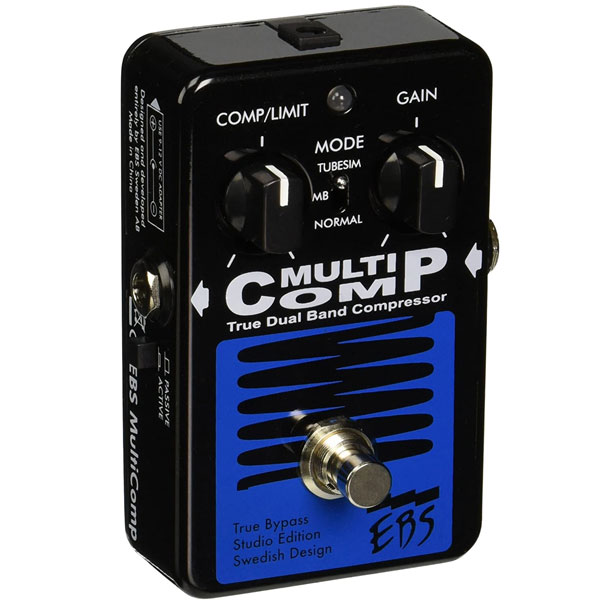
| Estimated Price | $230 |
| Type | Analog Multi-band Bass Compressor Pedal |
| Compressor Tech | Multi-band compression |
| I/O | 1×1/4” input, 1×1/4” output |
| Power Supply | 9V-12V PSU or 9V block battery |
My Review: EBS Sweden is a well-known pedal maker among working musicians. Their pedals are rugged and are built to high-quality standards. With the Multi-Comp, they’ve created a true analog dual-band, studio-quality compressor in a pedalboard-friendly format. It has a simple control layout with 2 knobs and a 3-way mode selector toggle switch. The Comp/Limit control sets the compression ratio of the compressor, it has a maximum ratio of 5:1 – it’s good for most situations, but this makes it less useful as a limiter. The Gain knob controls the output volume (make-up gain) of the pedal. The 3-way switch lets you select the type of compression between TubeSim, Multi-Band, and Normal(standard compression). The threshold can be set using 2 internal trim pots, in TubeSim and Normal modes the “low” pot sets the overall signal threshold, while in Multi-Band mode you can individually set the thresholds for the 2 frequency ranges. The Multi-Comp is a very quiet pedal even when you turn the compression all the way up – this is due, in part, to the low maximum compression ratio. The Normal and Multi-Band modes sound very clean and transparent, while the TubeSim mode boosts the midrange and adds a nice harmonical richness and warmth to your tone. You just can’t make this pedal sound bad, whatever settings you chose. The pedal has a fixed attack time and can feel too long in some situations, as some initial peaks are too fast to get caught by the compression. There’s an active/passive switch on the left side of the pedal to accommodate high- or low-output basses without distorting.
Key Specs: The Multi-Comp is an analog multi-band compressor pedal with a simple 2 knob layout. The Comp/Limit knob sets the desired compression ratio from 1:1 up to 5:1, while the gain knob sets the output volume or make-up gain of the pedal. The 3-way mode selector switches between compression modes: TubeSim, Multi-Band, and Normal. The threshold can be adjusted via 2 Internal trim pots for each of the 2 frequency bands. There’s an active/passive switch on the left side of the pedal, used when playing active or passive basses, and it features true bypass switching. It can also run on a 9V battery or 9V-12V PSU.
Target Customer: This is a simple pedal that offers a good amount of tonal versatility in a small package for the working bassist. The Multi-Comp is very transparent in its Normal and Multi-Band modes, while the TubeSim mode adds a lot of character and warmth to your sound. There are certainly more tweakable compressors out there, but this one will sound clear and musical whatever settings you use.
Bottom Line: The Multi-Comp is a great analog compressor, the Multi-Band feature ensures that you always have the perfect amount of compression in all frequency ranges. It’s not cheap but it’s built like a tank and it just sounds great.
11. Ampeg Opto Comp
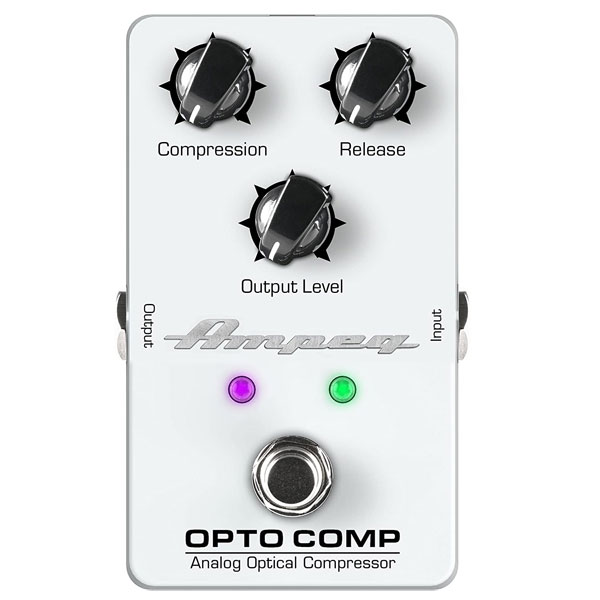
| Estimated Price | $130 |
| Type | Analog Bass Compressor Pedal |
| Compressor Tech | Optical compression |
| I/O | 1×1/4” input, 1×1/4” output |
| Power Supply | 9V PSU or 9V block battery |
My Review: The Opto Comp is a fairly recent addition to Ampeg’s bass pedal line-up. It’s a good quality compressor built around an all-analog optical compression circuit. It features a 3-knob control scheme: Compression knob sets the compression ratio between 1:1 fully counter-clockwise to 10:1 fully clockwise, Release determines how quickly the compressor lets go of your signal and stops working, it ranges between 75ms-600ms, and Output Level sets the make-up gain of the pedal. It’s a very simple design that produces great vintage-sounding compression tones.
The 1:1 ratio makes it useful as a clean boost that adds warmth and some light grit to your signal if you so desire. On the top plate of the Opto Comp, you’ll find 2 LED’s, the one on the left lets you know when the compressor is on, but the green LED on the right side is actually part of the optical compression circuit (with a light-sensitive photo-cell underneath, determining the amount of compression to be applied based on the level of the incoming signal). It lets you see when the Opto Comp starts compressing or how much it compresses your signal based on the intensity and duration of the shining LED. This makes setting up your compressor a breeze – the brighter the LED, the more gain reduction is applied. The Opto Comp is not a transparent compressor, it clearly shaves off some of your high-end and enhances the lows, though it has a warm and musical tone, with some growl to it once you crank up the Output level. The action of the compressor is smooth and round, with a low noise floor. Due to its inherent design, attack times are quite slow, and not tweakable except through the dynamics of your playing. There’s an internal -15dB pad jumper that will help to accommodate instruments with a hotter output.
Key Specs: The Opto Comp is a straightforward optical compressor. It has 3 controls: Compression ranging from 1:1 to 10:1, Release ranging from 75ms to 600ms, and Output Level to set the amount of make-up gain. It can be used as a clean boost that adds a little warmth to your tone. It features a true bypass circuit and has a gain reduction LED that makes it easy to visually confirm how much compression you get while playing. The Opto Comp can be used with guitars or keyboards, not just the bass guitar. It can be powered either with a 9V battery or 9V standard PSU.
Target Customer: This is an all-analog optical compressor from Ampeg, with simple controls and great vintage tones on offer. It is limited in its tweaking potential, but all optical compressors are, in this respect. The Opto Comp does a good job of smoothing out your peaks while adding warmth to your sound. It would fit in well with almost any style of music, leaning more towards the rock or funk side of things.
Bottom Line: The Opto Comp offers a good amount of control for an optical compressor. It’s very quiet with moderate settings but you start to hear some hiss if you crank up the make-up gain. The sounds you get from it are round and smooth, the build quality is pretty good and it is very well priced.
Choosing the Right Bass Compressor Pedal (Buying Guide)
As I said at the beginning of this article, bass compressors (and compressors in general) are some of the most underrated effects pedals. Some refuse to even call them effects pedals! This is because they alter your sound in a less noticeable way than say, a distortion, or a fuzz pedal will. Understanding what a compressor does and what all its controls do is also very helpful when you are shopping for one, as not all compressors have the same control layout: Some manufacturers give you more control options over your compressor, letting you dial in specific settings (more control knobs), while others go for more automation with fewer controls, keeping things simple but limiting your options when tailoring your sound. Compressors come in all shapes and sizes, from small pedals to large rack-mounted units and software plug-ins on a computer, but here we’ll be focusing on the pedalboard-friendly format.
What is Compression?
Before talking about compression we’ll need to discuss “Dynamic range”. Dynamic range in music is the change in volume from the quietest to the loudest sounds you can produce on your bass and is expressed in decibels or dB.
A compressor will take your dynamic range and compress it into a narrower band. As a result, your quiet sounds will become louder while your loud sounds will be quieter.
Why Do You Need a Compressor?
A compressor should be one of the first pedal purchases a bass player would think about.
Reducing your dynamic range may sound counterintuitive at first, but squeezing your sound into a narrower band will make your bass more easily heard, or “cut through the mix” more easily, meaning you’ll be able to roll back your volume and still hear yourself in a crowded band setting. In theory, a compressor will not change your fundamental tone at all, it will only affect the volume of the extremes in your playing, but in practice, you will lose some frequencies when you turn it on. With some pedals, this is more of an issue than with others.
Compression will keep your signal hot and free from distortion or clipping, ensuring that you have a clear and even bass tone. At the end of the day, a compressor will make your playing sound fuller, smoother, more even, and more professional.
Besides smoothing out your sound, a compressor is also very useful with bass playing when switching between playing styles like from fingerstyle to slapping. Slap bass has you hitting and popping your strings much harder than with fingerstyle or with a pick (having a wider dynamic range), so if you switch from one style to the other during a song, a compressor will keep your tone nice and even.
A compressor should usually be among the first pedals in your signal chain, but it can also be placed further down the signal path when employed to smooth out the differences in volume created by effects that alter your dynamic range, like with auto-wah or synth pedals.
Adding a compressor to your setup will also increase the sustain of your bass – it makes quiet sounds louder, but any mistakes in your playing will also be more noticeable.
Bass Compressor Terminology
A compressor will have 5 basic parameters that influence the way it behaves when running a signal through it:
Threshold – The threshold control determines at what level the compression will kick in. When your signal is louder than the threshold you’ve set, the volume will be reduced or compressed. The lower the threshold setting, the more compression will be applied. A higher threshold setting will result in only the loudest notes being compressed, meaning that your dynamics will be mostly left intact. A high threshold will have less compression added.
Ratio – The ratio setting will determine by how much your signal volume will be reduced. The higher you set your ratio, the greater the amount of compression that will be applied to the signal that passes above the set threshold. A ratio of 2:1 means that the signal will be attenuated by 2dB for every 1dB above the threshold, at a ratio of 4:1 it will be 4dB lower for every 1dB above, and so on. At higher ratios, you’ll have the most consistent volume, but the tradeoff is that your dynamic range will be squashed. If you want to absolutely limit your volume(to protect your speakers for example), you can set the ratio to :1, meaning that your signal will be cut off after reaching the set threshold. Most bass players usually choose a ratio ranging from 2:1 to 4:1 to benefit from some peak reduction without losing too much of their dynamic range.
Attack – The attack setting determines how quickly the compression will kick in after reaching the set threshold and is measured in milliseconds. Short attack times are used to reign in transients like with slapping or when playing with a pick, smoothing out your sound, and keeping the peaks under control. But too fast attack times will affect all peaks, making the bass sound unnatural. Long attack times will result in increased sustain but will allow most of your transients to pass through unaffected.
Release – The release or decay setting determines how long the compressor remains engaged after you dip below your set threshold and is measured in milliseconds. Optimum release times are dependent on the performance of the player (playing style, tempo, and music genre) so a little experimentation is key. Fast release times will bring out low-level details in your playing making your bass sound denser and thicker with increased sustain, but too fast release times can introduce distortion (just set longer times until it disappears).
Hard knee/Soft knee: A hard knee will make the compression kick in at the set ratio as soon as it reaches the threshold. A soft knee gradually increases the compression until it reaches the set ratio when approaching the threshold. This can help make the transition between no compression and compression gentler and more subtle. This parameter is rarely seen on pedal-format compressors.
Input level – The input level determines the level of the signal going into the compressor circuit. The input level also influences how the compressor will react(the threshold being dependent on the volume of the signal). High input levels will make the compressor hit the threshold sooner.
Output level/make-up gain – Because you’re reducing the dynamic range of your signal, you will notice a drop in overall volume when the compressor is engaged. In this case, ‘making up’ the volume level is often necessary. This comes with the side effect of also turning up the volume of the quieter notes, which can be an easy way to add punch. The quiet notes will be closer in volume to the compressed peaks. But too much boost in make-up gain due to high compression raises the noise floor, which can make a compressor noisy or prone to hissing.
Types of Bass Compressors
In essence, there are four types of compressors based on the technology they employ to compress your signal: VCA, Optical, FET, and Valve. Each type has its own characteristics and performs better with some applications and worse with others.
VCA compressors
This is the most common type of compressor. The VCA stands for Voltage Controlled Amplifier, and they feature some of the fastest response times for the attack and release parameters. VCA compressors are known for their clean, transparent sound and very little distortion and coloration of your signal; they also offer the highest amount of gain reduction when compared to the other compressor types. The design of VCA compressors usually allows for a lot of control over your parameters. VCA compressors work by splitting your incoming signal into 2 paths through the use of an integrated circuit: the detector path (that controls the compression effect), and the output path.
They are very sensitive to micro-dynamics and transients making them ideally suited for percussive instruments, but you’ll commonly find them used with basses, guitars, and even vocals. If you are looking for a transparent compressor with low distortion, to even out your signal when switching from fingerstyle to slapping or popping, this could be the best choice for the task.
Optical compressors
Optical compressors are unique as they use light to achieve their effect, or to be more specific, light-dependent resistors. The incoming audio signal is fed into a light source, usually a LED (light bulbs were used in older designs), the LED will then shine upon a light-sensitive resistor. A hotter signal results in a brighter LED. The light-sensitive resistor will determine (based on the brightness of the LED) how quickly and by how much the incoming signal will be attenuated. Because of their design, optical compressors are not as fast in their response as other compressor types are, and the way the photocell reacts to the light source ensures that there will be a slight delay in the attack and release of the effect. This inherent delay has many describing optical compressors as being smooth and musical. Their sound is also dependent on the materials used in its construction. Different types of light sources will illuminate at different speeds and the light-sensitive resistor will also react differently depending on the materials from which it is made. Besides being the slowest form of compression, the attack and release of this type of compressor are usually not linear in their response, having a fast initial activation with a tapering off effect. Another thing to consider is that this type of compressor doesn’t have a lot of sound tweaking options when compared to other types of compressors. Optical compressors are used when a smooth and rounded sound is required without squashing your transients. With higher compression ratios, the low-end can get accentuated. It is commonly used for bass, guitars, and vocals but its effectiveness depends on the performance.
FET compressors
FET stands for Field Effect Transistor, the “transistor” part of the name refers to a semiconductor that can amplify as well as attenuate an incoming signal in accordance with the dialed-in settings. There is some confusion about the difference between FET compression and VCA compression, some claiming FET to be a subset of VCA. But where VCA has its transistor housed in an integrated circuit that responds to the voltage of the incoming signal, a FET will work with the electrical field in its entirety, and gain changes result from the change in electrical charge in addition to voltage. FET compression was designed to emulate tube compression more reliably. FET compressors have similar applications to the VCA variety, being able to tame transients with their fast attack times making them well suited for percussive performances. FET compressors will color your tone though when compared to VCA’s, many describing them as sounding bright and punchy.
Tube compressors (variable MU or Delta MU)
These are the earliest compressor designs. Tube compressors use tubes or valves for gain reduction. One of the particularities of these compressors is that they have nonlinear compression ratios. The ratio will increase along with the gain reduction meaning, a louder transient will be compressed more. They are much slower in their response times compared to FET or VCA compressors but they add the most color and character to your sound. People tend to describe them as sounding “musical”, warm, thick or creamy. They are ideally used for bass, guitars, or vocals but keep in mind that quick response to transients is not really on the table. If you are looking for a “punchy” sound or if you want to address big dynamic variations, a tube compressor might not be the best choice. There are also compressors on the market that are called “tube compressors” but these don’t use the tube for gain reduction, the tube is just used to add color and warmth to your tone.
Additional terminology
Multi-band compression
Multi-band compressors are not usually found in pedal format, but there are a few out there. Standard compressors take your signal and squash it across the whole frequency spectrum, this can result in artifacts, such as too much bass or a harsh high end. A multi-band compressor is able to work differently on different frequencies, letting you tailor your sound much more precisely. It allows you to dial in the amount of compression you want by frequency: more or less compression of the lows than the highs, or vice versa, or any combination you should desire. Multi-band compressors let you dial out compression artifacts that can sometimes occur with standard compression, by reducing or increasing the amount of compression in that specific frequency band. They work by passing your incoming signal through several filters, isolating specific frequency bands, compressing each one individually, recombining the split signals at the end.
Parallel compression
Parallel compression (sometimes called New York Compression) is a compression technique that has become more popular among performing musicians in recent years. It is achieved by running a compressed signal in parallel with an uncompressed signal (or lightly compressed) and blending the two signals together at the end. This allows the player to dial in the desired amount of compression and then mixing in a dry signal, eliminating unwanted compression artifacts. One application of parallel compression is when you want to increase your sustain, since the amount of compression needed to increase sustain is rather high, and this can result in a squashed attack, where the initial part of the attack can be much lower in level than the sustained note. By blending in your dry signal, you can retain the initial attack and also benefit from the increased sustain.
Setting up Your Compressor
Setting up your compressor for bass guitar can be tricky as there are no set rules (it is greatly dependent on your playing style, performance, and music genre) but here are a few tips to point you in the right direction.
- Set your compression ratio to somewhere between 2:1 and 4:1 (too much compression can lead to a lifeless sounding bass as the dynamics are reduced too much)
- Set the attack to a moderately fast time, somewhere between 75ms-150ms should be fine for most situations
- Set the release to a fast time, 25ms-50ms
- Turn up the threshold and slowly roll it off (while playing) until you hear a slight decrease in your volume level – this is the level at which the compressor kicks in
- Now start to decrease the attack time until the bass sounds less aggressive(you’re cutting off transients), when you reach this point increase the attack just a bit
- Turn your compressor on and off while tweaking the make-up gain until you stop hearing a difference in volume between the compressor being on and off
Going through these steps should set you on the right path, just remember to listen to your sound and keep tweaking until you like what you hear.
Wrap up:
That does it for this review, let us know what bass compressor you’re going with or if you think there are any pedals we left off this list that should be added!

My name is Chris and I’ve had a passion for music and guitars for as long as I can remember. I started this website with some of my friends who are musicians, music teachers, gear heads, and music enthusiasts so we could provide high-quality guitar and music-related content.
I’ve been playing guitar since I was 13 years old and am an avid collector. Amps, pedals, guitars, bass, drums, microphones, studio, and recording gear, I love it all.
I was born and raised in Western Pennsylvania. My background is in Electrical Engineering, earning a Bachelor’s degree from Youngstown State University. With my engineering experience, I’ve developed as a designer of guitar amplifiers and effects. A true passion of mine, I’ve designed, built, and repaired a wide range of guitar amps and electronics. Here at the Guitar Lobby, our aim is to share our passion for Music and gear with the rest of the music community.
